A newly installed Wi-Fi network at agricultural research center in California may enable researchers to view field data in real time while serving as a proof-of-concept for rural communities needing low-cost Internet access.
PARLIER, California — Outside the small San Joaquin Valley town of Parlier, 20 miles south of Fresno, California, the University of California’s Kearney Agricultural Research and Education Center looms over farmland. Much more impressive in person than on Google street view, the center looks like a mini university campus — which is how KARE describes itself. Researchers have studied agriculture in this location since 1965, when local farmers pitched in to buy the land and donate it to the University of California Agriculture and Natural Resources (UC ANR). KARE is one of nine research and extension centers (RECs) under the umbrella of UC ANR around the state, one of which is nearby Lindcove (LREC).
At 330 acres, KARE sits on some of the most productive land in the world, surrounded by a maze of level farmland in the heart of flat, fertile farm country located in California’s No. 1 agricultural county. Yet the area has been a virtual desert of dismal Wi-Fi coverage.
“I’ve been in Africa recently and the mobile coverage there was better,” said Dr. Jeffery A. Dahlberg, director of KARE, referring to some rural areas around the center. “It’s embarrassing,” he said, given the relative wealth of United States.
Dahlberg, a former Peace Corps volunteer in Africa and life-long California farmer and agricultural scientist, runs KARE, which has over 100 research projects and grows over 50 crops. The center provides a base for over 150 researchers, many of whom come from the UC system. As the director of the center, he recently oversaw the installation of a wireless connectivity on 10 poles bringing Wi-Fi throughout the fields. The addition of the wireless system coincided with a boost to a 1 Gbps fiberoptic network, which is managed by CENIC, the nonprofit network operator for California Research and Education Network (CalREN). During a July 9th visit, the new fiber and wireless system had been up for 10 days.
Rural areas in Africa that have leaped directly to mobile for phone service may actually be a good example for rural America. The vendor installing the Wi-Fi last-mile at KARE also installs Wi-Fi connectivity in African villages and other low-income, rural places around the world. BlueTown, headquartered in Denmark, has installed low-cost solar-powered Wi-Fi base stations that serve as hot spots around the world. The hot-spot range reaches one kilometer and a solar-charged battery runs the connection at night. The BlueTown hot spots connect to the Internet by satellite or other infrastructure already existing in the locations. BlueTown also installs a cloud among the base stations for network stability and to disseminate health, education and safety information.
Many of BlueTown’s executives came out of Nokia, one of the pioneers of mobile.
The Wi-Fi system installed
BlueTown’s setup at KARE was 10 poles and tower, delivering a 250-Mbps connection. BlueTown doesn’t focus on the traditional telco-type of setup; it is a low-power solution that doesn’t have the same range. The poles peppered around KARE have an omnidirectional antenna on top with a 250-meter radius of Wi-Fi signal.
“You can set up 200 of those within the nine miles of a tower we set up,” Nick Pallesen, CCO of BlueTown explained during a walking tour. Each antenna does need line of sight with the main tower. If power isn’t available, the poles come with a battery backup and solar panels. Unless connected to the LAN, the poles also have a small dish that broadcasts back to the tower.
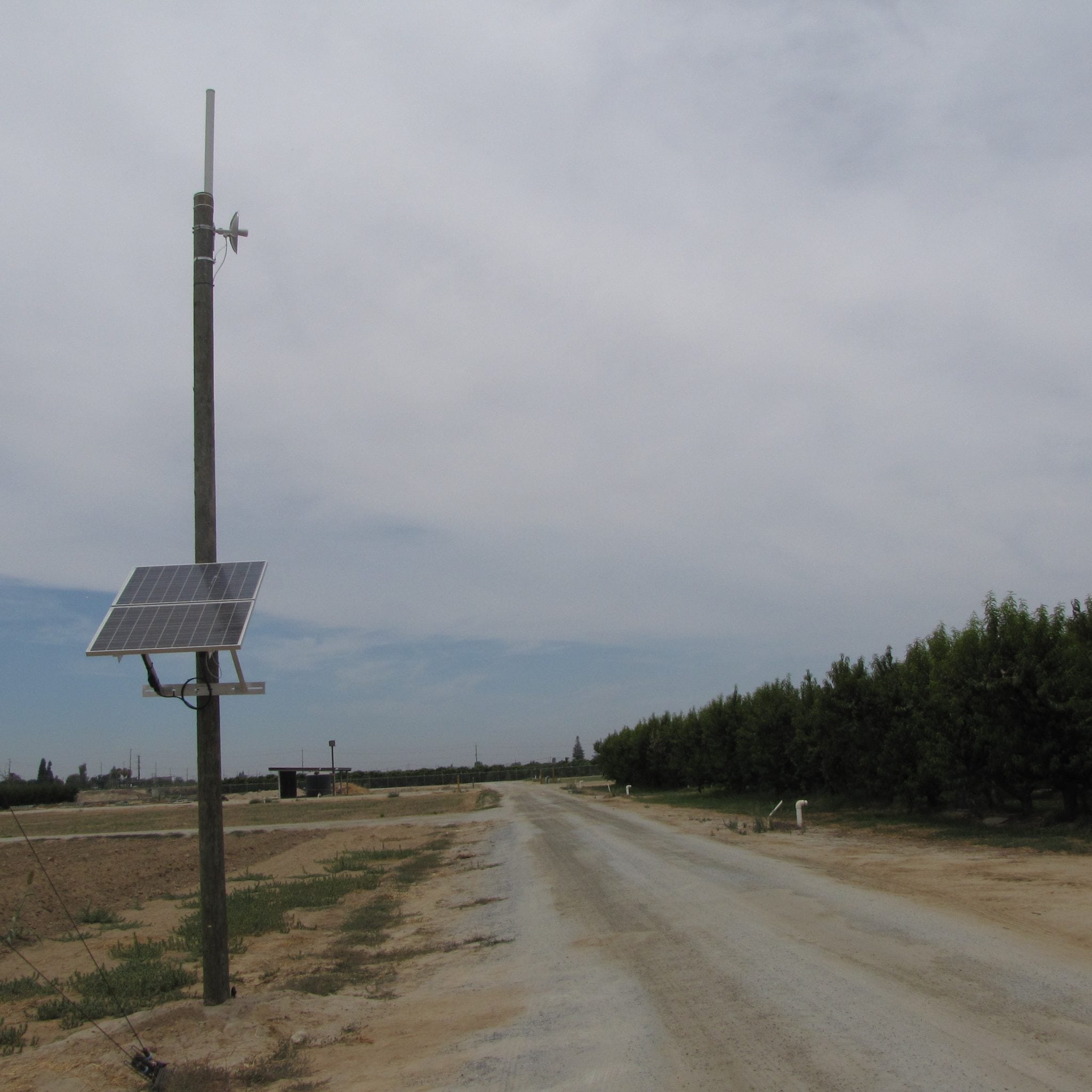
One pole in UC ANR’s KARE Center’s Newly installed Wi-Fi system. The low-power, low-cost system was installed by BlueTown, a company that installs similar systems in poor, underserved areas around the world. (Image: RCR Wireless News/Susan Rambo)
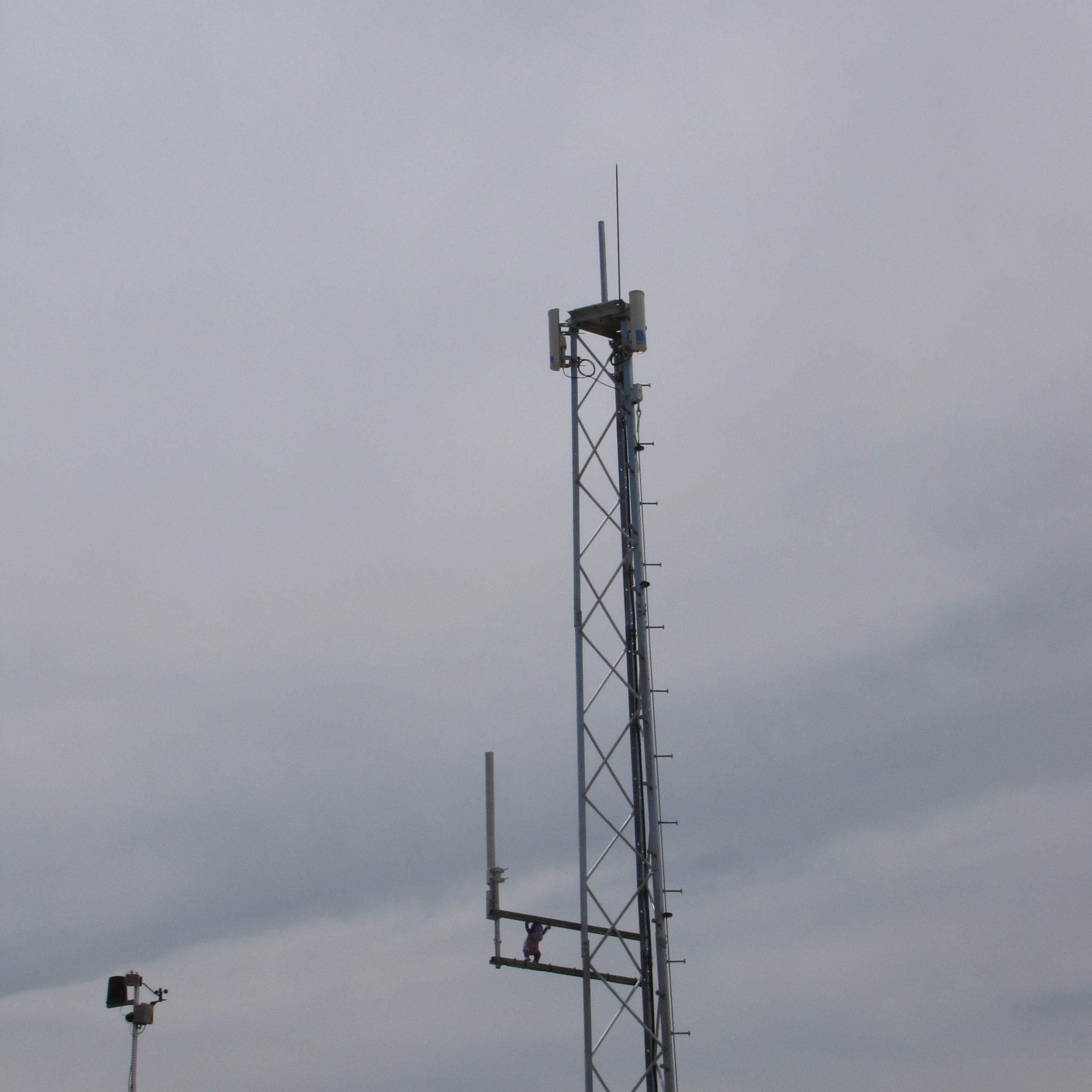
The new Wi-Fi tower at UC ANR’s KARE Center near Fresno, Calif. The tower is central to the line-of-sight, low-power, low-cost Wi-Fi system, designed and installed by BlueTown. The monkey is an added benefit. (Image: RCR Wireless News/Susan Rambo)
“The middle mile is 5.8 GHz, and then it broadcasts on 2.4,” said Pallesen. “We are looking at all technologies that are not based on license. We are also looking into TV white space and the whole white space area. Our focus in making this as affordable as possible in the solutions available in the technologies available.” The whole solution was around $60,000 for the tower and 10 poles. The system is connected to fiber for backhaul.
KARE anticipates building on the system over time. “I am excited because we are just starting to figure out what we are going to do with this,” said Dahlberg.
For example, one alfalfa field has sensors throughout, looking at sub-surface irrigation compared to flood irrigation. That data is currently kept on-location in the field until someone goes to collect it and take it back to the office for processing. “One of the nice things about the W-Fi is we can move to real-time evaluation of the data that is coming off this field,” said Dahlberg. That data is being sent now to a company that returns the data after processing.
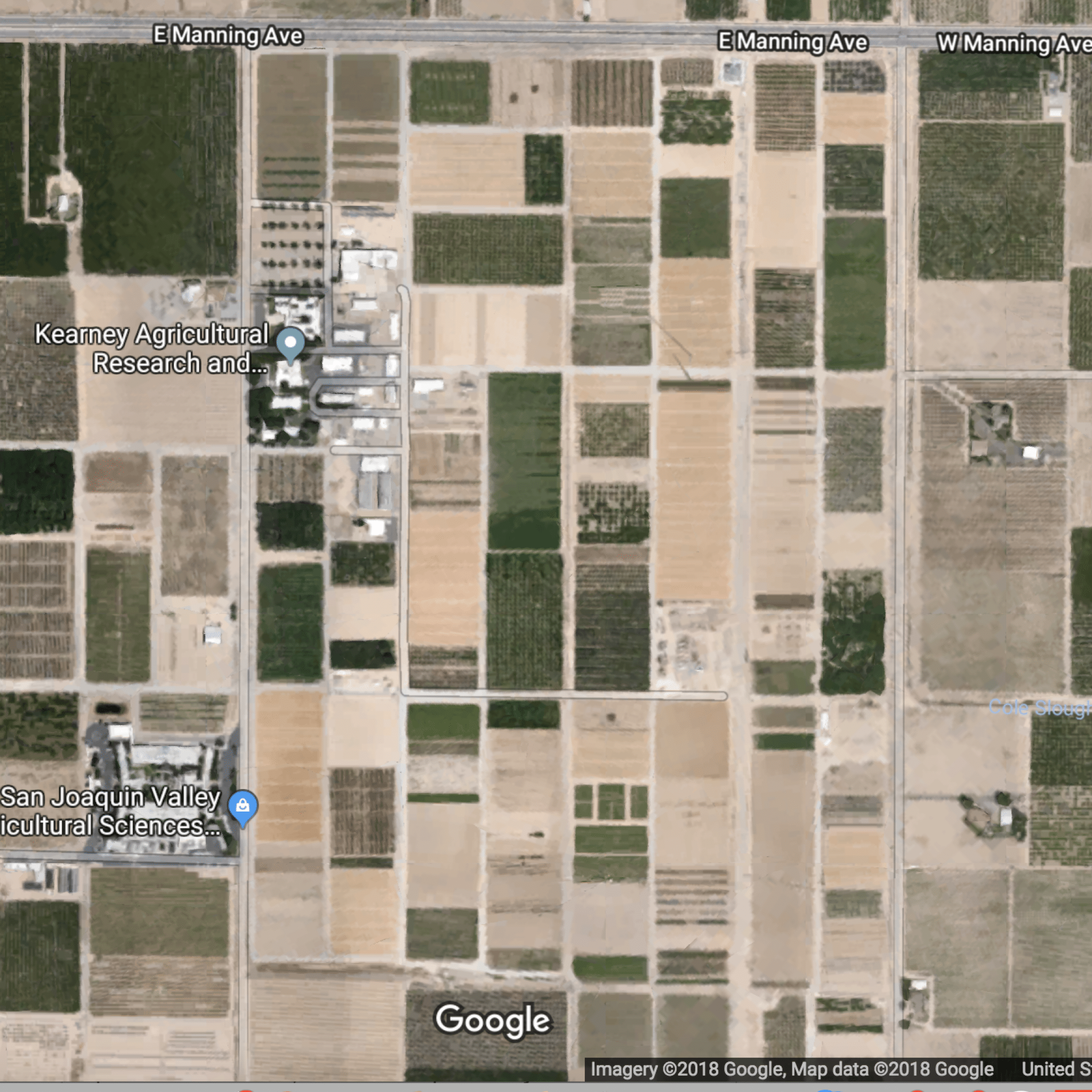
The Google Maps satellite view shows the smaller field sizes at Kearney Agricultural Research and Extension Center near Fresno, Calif.
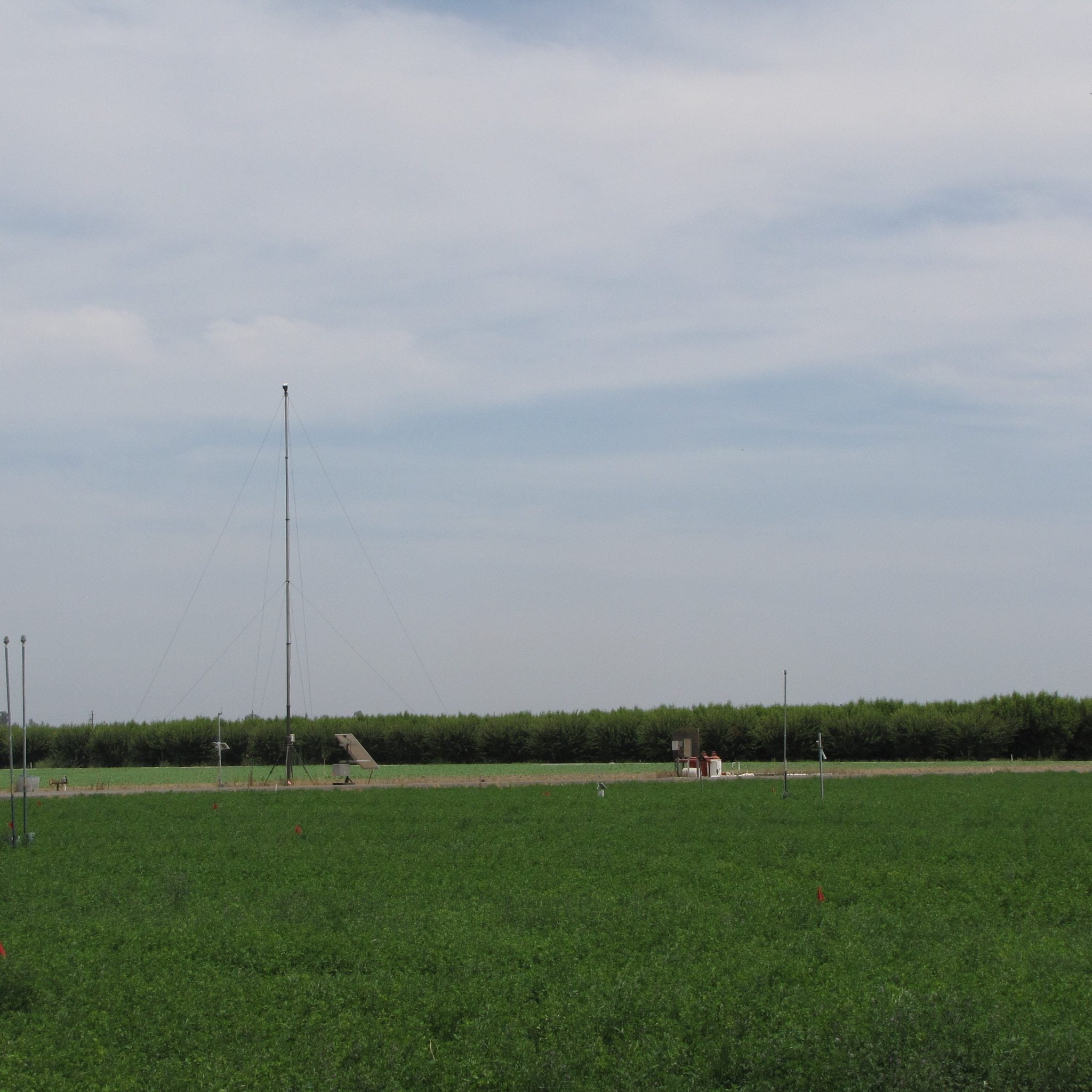
A picture of an alfalfa field with KARE’s irrigation study of drip versus flood irrigation. The data from infield sensors are sent to the tower, where a datalock holds the data until someone retrieves it. A new Wi-Fi system makes it possible to one day provide this data available in real time. (Image: RCR Wireless News)
An outside company is doing infrared imaging of the field, based on camera technology they bought from the U.S. Department of Agriculture. “We are getting a look this field every 15 minutes and how it is responding to the irrigation strategies we have implemented in the field,” Dalhberg said. “It has a cellular connection, we are going to work with them to get them on the Wi-Fi connection.”
“I am envisioning that most of the monitoring we are doing here, we will be able to do in real time,” said Dahlberg, adding that the center will also be able to increase worldwide accessibility to its data. “I am pretty excited to be able to do that.”
Wi-Fi may make real-time phenotyping possible
“For us in the research community, it is all about building a phenotypic database that we can relate back to gene expression,” said Dahlberg, during a tour of the KARE’s research blocks, “because the ultimate goal is to use gene discovery to help us feed the world.
“We want to be able to find genes that are present in certain crops we can utilize to see if they are in these other crops, and if they are, how do we use them; how do we turn them on,” he said. “We might be able to do that with CRISPR technology.”
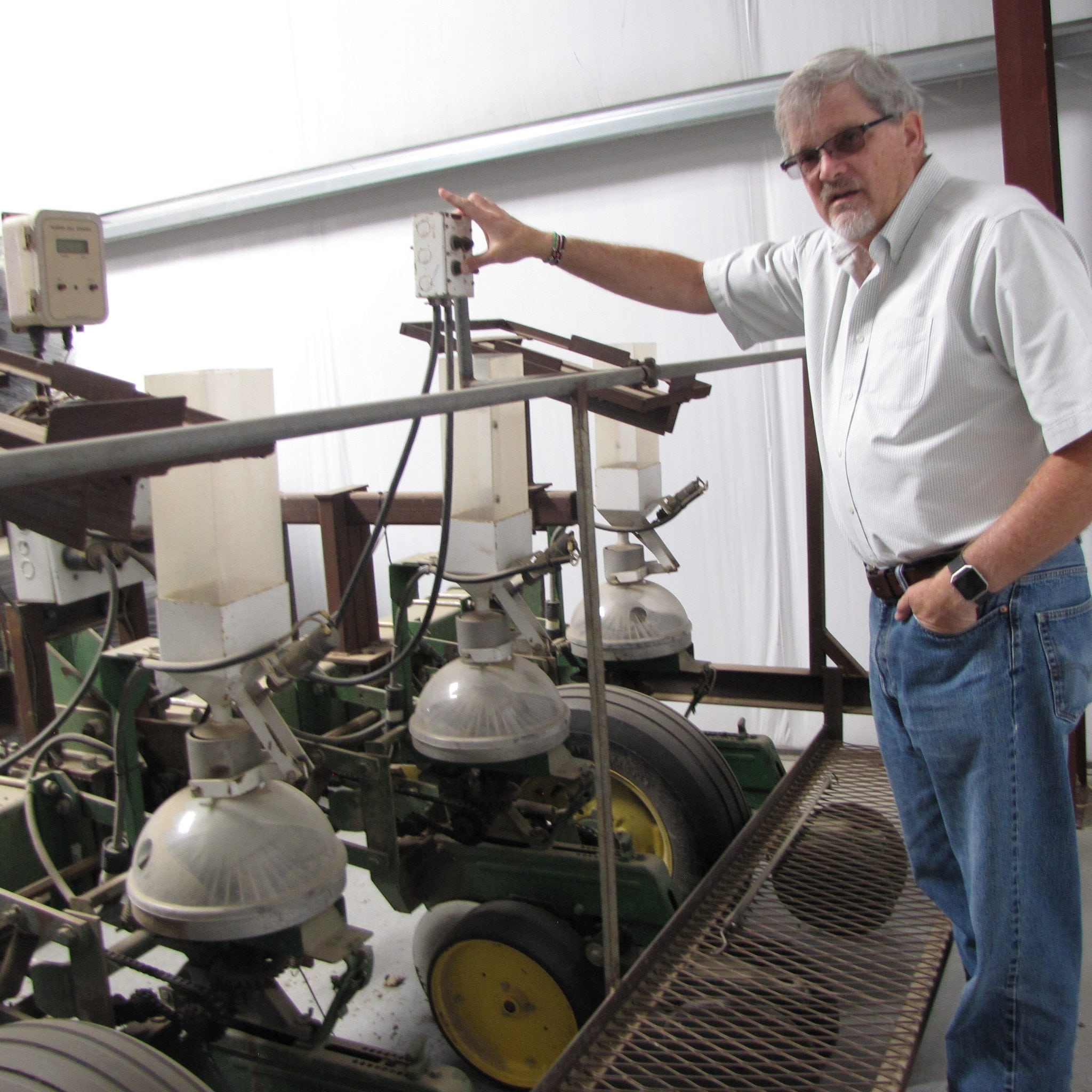
Dr. Jeffrey A. Dahlberg, director of the UC Kearney Agricultural Research and Extension center, explains why an older seed planting machine is so labor intensive. (Image: RCR Wireless News/Susan Rambo)
Plant phenotyping is a comprehensive gathering of all the descriptive traits of a plant, a physical assessment of the plant. Quantitative data includes the plant’s “anatomical, ontogenetical, physiological and biochemical properties,” according to an article by Achinm Walter, et al. Basically, various sensors and cameras can capture the data, as well as humans doing old-fashioned observations.
“The nice thing about putting all this Wi-Fi into this research center is we will be able to start doing real-time phenotyping with different probes,” Dahlberg explained. “We will be able to develop probes that will allow us to do different things. For instance, putting heat probes on trees and the leaves, or on annual crop leaves. We can start doing real-time monitoring of things in the field.”
Commercial companies make equipment that promises to capture plant phenotypical data without destroying the plant. They also promise collecting data for a field or canopy of plants, not just a single specimen. A good explanation of plant phenotyping can be found on one vendor’s site. “Phenotypic data help to explain gene functions,” says LemnaTec on its website. “They also give insight how plants cope with limitation of water and nutrients, how they respond to light or CO2 and how pests and pathogens take influence on the phenotypes.”
“Plants adapt to the environment in which they grow and environmental factors influence the plants’ phenotypes. This means that plants with the same genomic properties, grown in different environments, can differ greatly in phenotypic properties,” says LemnaTec.
KARE is studying plants’ phenotypical data as it changes throughout the day in response to environmental conditions. In a multi-year study, KARE is collaborating with the USDA and the U.S. Department of Energy to study how the drought-tolerant grain sorghum reacts under different drought stresses in hopes of finding the gene that is the key to its drought tolerance.
The sorghum is divided into three 600-plot sections on a 6.5 acre field. The three sections undergo different drought stress: One gets regular water throughout the experiment; another section gets stressed with no water before it flowers; and the third section gets stressed (in other words, no water) after flowering.
“We are looking at sorghum as an annual renewable feed stock,” said Dahlberg. Because of sorghum’s drought tolerance, the crop is a model for gene discovery for drought response. The good thing about studying drought in California is that you can really simulate a drought easily on a field-scale by just turning off the water. Other climates have summer rain, making a drought study difficult to impossible. “In Texas, we’d get a summer rain and our drought nursery was kaput,” said Dahlberg.
Another good thing: The data is gathered by drones.
Drought and drones
Drones are helping the researchers collect the phenotype data much faster than humanly possible.
“While we spend billions of dollars to study human genes and gene expressions, and “have a lot of phenotypic data that we can correlate back to genes,” Dahlberg said, “we are at opposite ends with plants right now. We don’t have a lot of robust phenotypic data because it is really hard to collect [phenotypic data]on plants to correlate back to gene expression on plants. One of the things drones are allowing us to do is get that information more rapidly.”
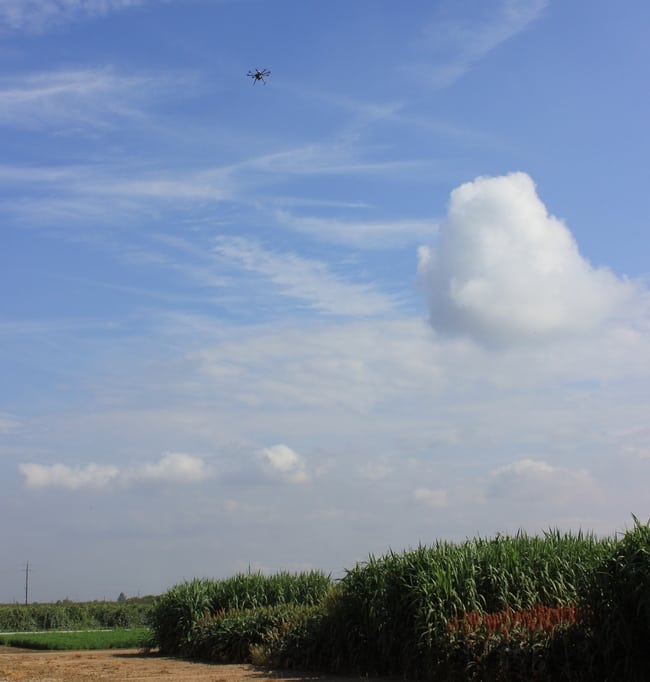
Drone flies over sorghum field at UC ANR’s KARE Center near Fresno, Calif. The drone is collecting phenotypic data for researchers. (Image courtesy of UC ANR)
The drones fly the fields weekly over a 16-week period, taking measurements of plant height and leaf-area index, along with biomass estimations, at all the different stress points. Blue River, a startup drone company from Sunnyvale, California, has provided the drone know-how. Founded by a couple of engineers out of Stanford University who decided they wanted to work in agricultural technology, “they were smart,” said Dahlberg. “They hired agriculture people to help them figure out what problems to tackle and what would work in the field.”
For lack of relable Wi-Fi in rural areas, Blue River created a van that has its own hot spot. The van itself is a prototype for an agricultural use: a mobile drone unit that can travel to the fields with full equipment on the ready. Blue River sends the field data to the cloud via their hot spot. (Eventually Blue River could use KARE’s new Wi-Fi system.)
“It is impossible to do a weekly index [manually],” said Dahlberg. If researchers had to collect the data manually, it would take two days to measure the height of all the plants, each week. “To do a leaf-area index would be impossible,” said Dahlberg. Manually, a leaf-area index takes an hour to do a two by three-foot section with a portable leaf-area index machine. Bio-mass estimations are destructive measurements, when done manually, that take a couple hours to do and involve weighing before and after plants are dried out to remove water. Biomass can only be done once at the end of the year.
“The drone flies that 6.5 acre field in 25 minutes,” said Dahlberg.
Although KARE proves the drones usefulness for researchers with its sorghum study, Dahlberg warns that science needs to prove ag tech usefulness for the farmer. “The science needs to come first when it comes to drones,” or any new technology at the top of a hype cycle, said Dahlberg. “How useful is the technology without more of a science-based ground-truthing? …It’s like any new technology: There is a lot of hype and not a lot of science to back it up.”
Wi-Fi system as proof-of-concept
The new wireless system at KARE could inspire the community around it. The issues were laid out during KARE’s reception announcing its new Wi-Fi system, on July 9th. In attendance were BlueTown, the Western Growers’ Association, local educators, the USDA’s ag and rural broadband strategist, CENIC representatives, farmers and other Wi-Fi and network operators.
Once the system is running for a while, KARE will present it to Parlier town members as an example of what the town could do. “There must be fiber optic going into the town somewhere,” said Dahlberg.
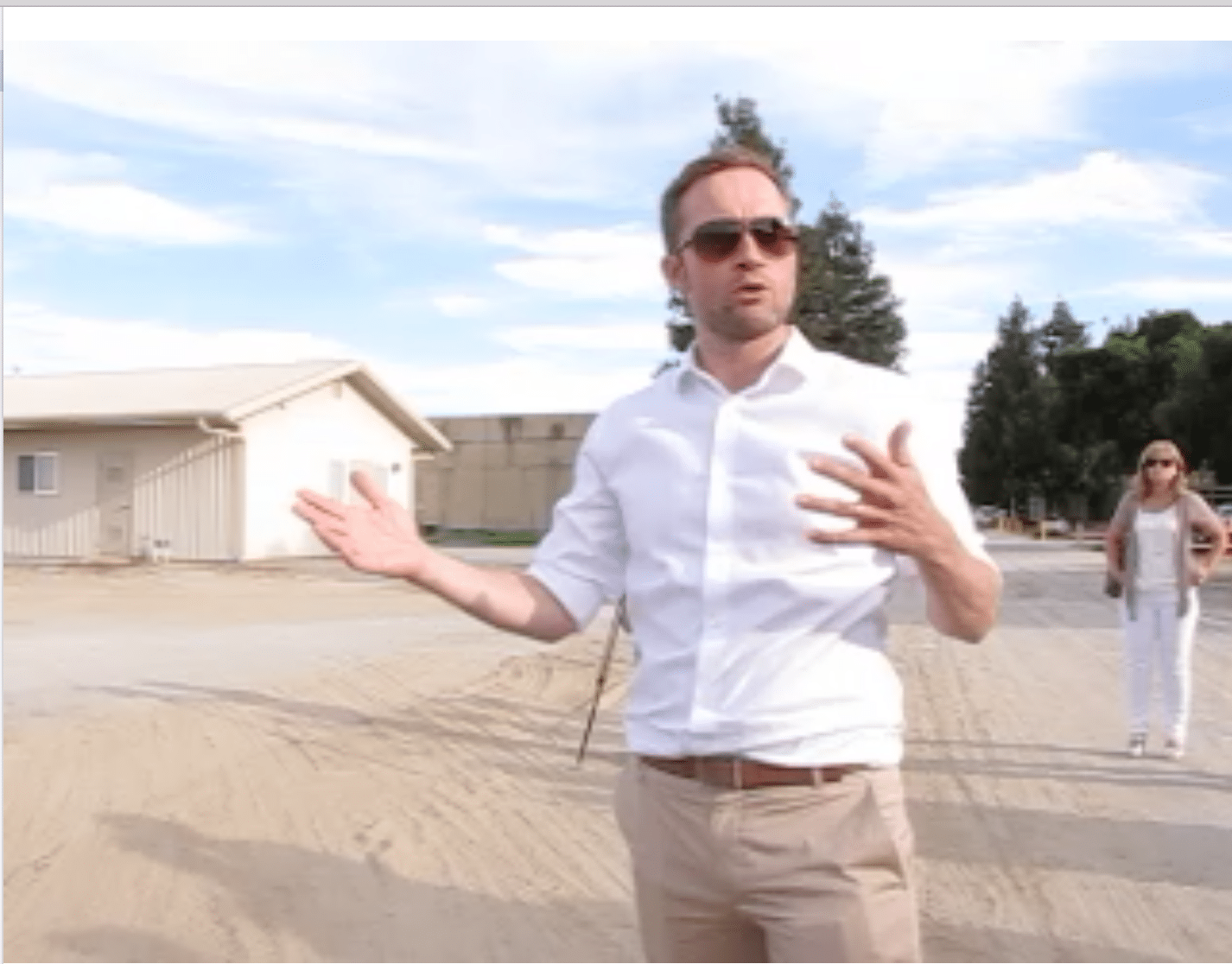
Nick Pallesen of BlueTown explains BlueTown’s Wi-Fi installation at UC ANR’s KARE Center, on July 9, 2018. (Image: RCR Wireless News)
“You can also do this [low-cost, low-power installation] in a community,” said Blue Town’s Pallesen. “If you have small houses around within the canopy [of the poles and tower], we could connect them in commercial terms and you can add that to the payback of the installation.”
Several speakers and attendees stressed the dire importance of improving wireless access in the local Fresno environs and rural communities. Many communities near Fresno don’t have Wi-Fi or cellular coverage, or the coverage is poor.
“Wi-Fi is [a]necessity for three basic reasons,” said Linda Thomas, the vice chancellor of educational services at the West Hills Community College District. Education, healthcare and economic development increasingly rely on a wireless connection, which is missing from a lot of communities around the Fresno area in the San Joaquin Valley.
“We’ve staked a stake in the ground,” she said. The West Hills Community College District is organizing the community for better connectivity. “I am here because I am excited…We are actively pursuing funds to put the infrastructure in, we have a business model we are looking at. We are also working with companies such as Vast and other companies that put fiber in the ground and put towers up. We are not playing. We are going to do it.”
Why? Within just the area served by the West Hills Community College District, the poverty level is 60% and the education level is half that of most Californians, said Thomas. With the lack of affordable Internet connection at home, students often can’t do their homework or take online classes when they’re off campus.
“Our students are going to be left out,” said Thomas.
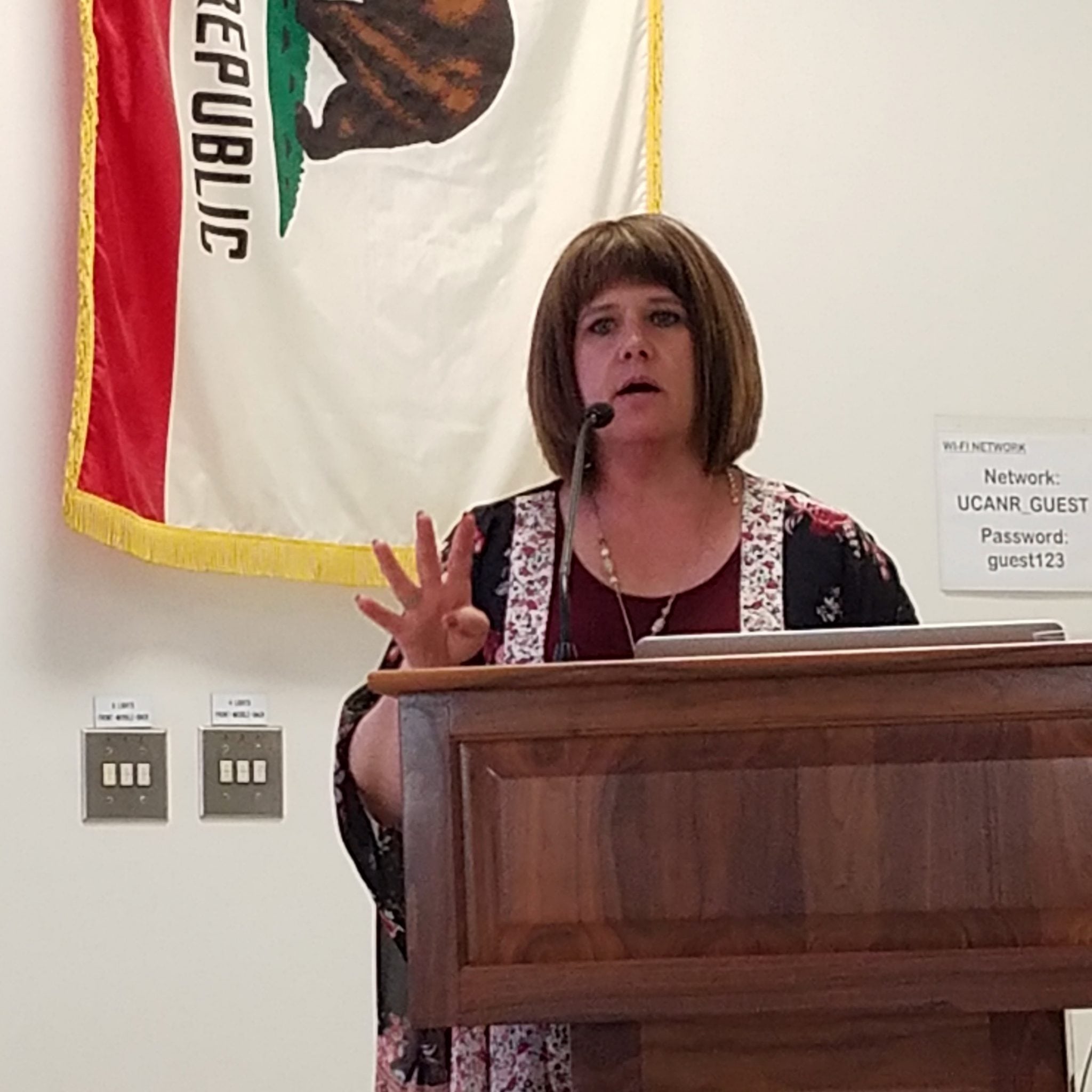
Linda Thomas, the vice chancellor of educational services at the West Hills Community College District, describes the dire need for wireless connections in Westside area near Fresno, Calif., during the reception for UC ANR’s KARE Center’s new in-field Wi-Fi system. (Image: RCR Wireless News/Susan Rambo)
More often now, connectivity is how healthcare is delivered. Wearable health monitors are sometimes a health necessity, and when hospitals close, such as the one in nearby Coalinga that recently shut its doors, connectivity becomes a life and death issue. It may be the only way to see a doctor without driving 50 miles.
The third is economic development. “We know that the ag-tech revolution is on the horizon… We have on our campus the farm of the future,” where students can learn how to use and program ag tech, said Thomas. “People whose family has grown up picking can now be that person who programs or flies that drone.” The college can train the students, yet they’ll have to go elsewhere for the jobs, said Thomas, because companies don’t want to set up shop when the connectivity isn’t there first.
Part of the West Hills Community College District business plan is to make Internet access affordable. “We are also raising money to supplement the monthly subscription fees for the Internet for our families,” Thomas said. The goal is to make the internet available for $12 a month per family. “We are talking to a lot of different people, like Chevron, the state government and the [California Public Utilities Commission], to raise money to supplement this.”
Some see fiber as a key. “We need a map of the existing fiber,” said Robert Tse, the USDA broadband strategist for rural and agriculture tech innovation in California. He has traveled the state widely and met with farmers and rural communities that didn’t know they had fiber placed near their fields and towns already. With a map of fiber, farms and communities can tap into the existing structure.
He also agreed with Thomas that good wireless connectivity is key to economic development.
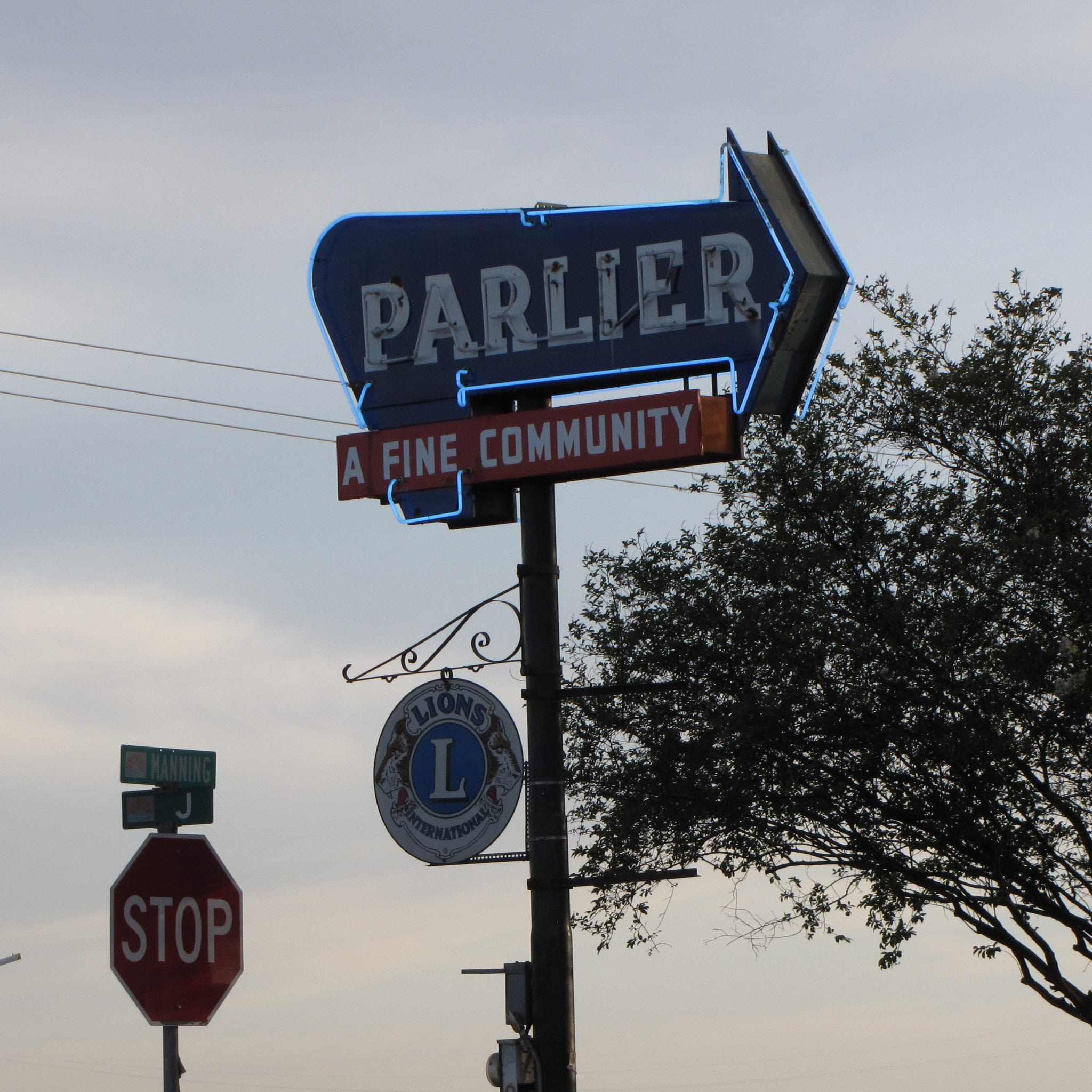
Neon sign on E. Manning Street announces the existence of the small town of Parlier, Calif., near the UC ANR Kearney Agriculture Research and Extension (KARE) center. (Image: RCR Wireless News/Susan Rambo)
More about KARE: Facts only an ‘ag geek’ could love
KARE also does a lot research on developing rootstock, the roots onto which a tree’s budstock will be grafted. Most orchard trees have been grafted onto rootstock. “There are several reasons you use rootstock. For the most part, rootstock can really fight against soil pathogens and nematodes,” said Dahlberg. Use of rootstock to keep trees smaller is not a new thing, but it is starting to become more popular among farmers in the Valley, said Dahlberg, because it “keeps the architecture of the tree down” to a manageable size that is less labor-intensive to harvest and care for.
The original pistachio trees used for the rootstock of half of the pistachio trees in the state are at KARE. Pointing to a huge male tree, Dahlberg explains that it is the male pistachio tree used crossed with a female (mother) tree to create a rootstock. “This was one of the original crosses to create a rootstock with good vigor and nematode and soil pathogen resistance (on the female side),” said Dahlberg.
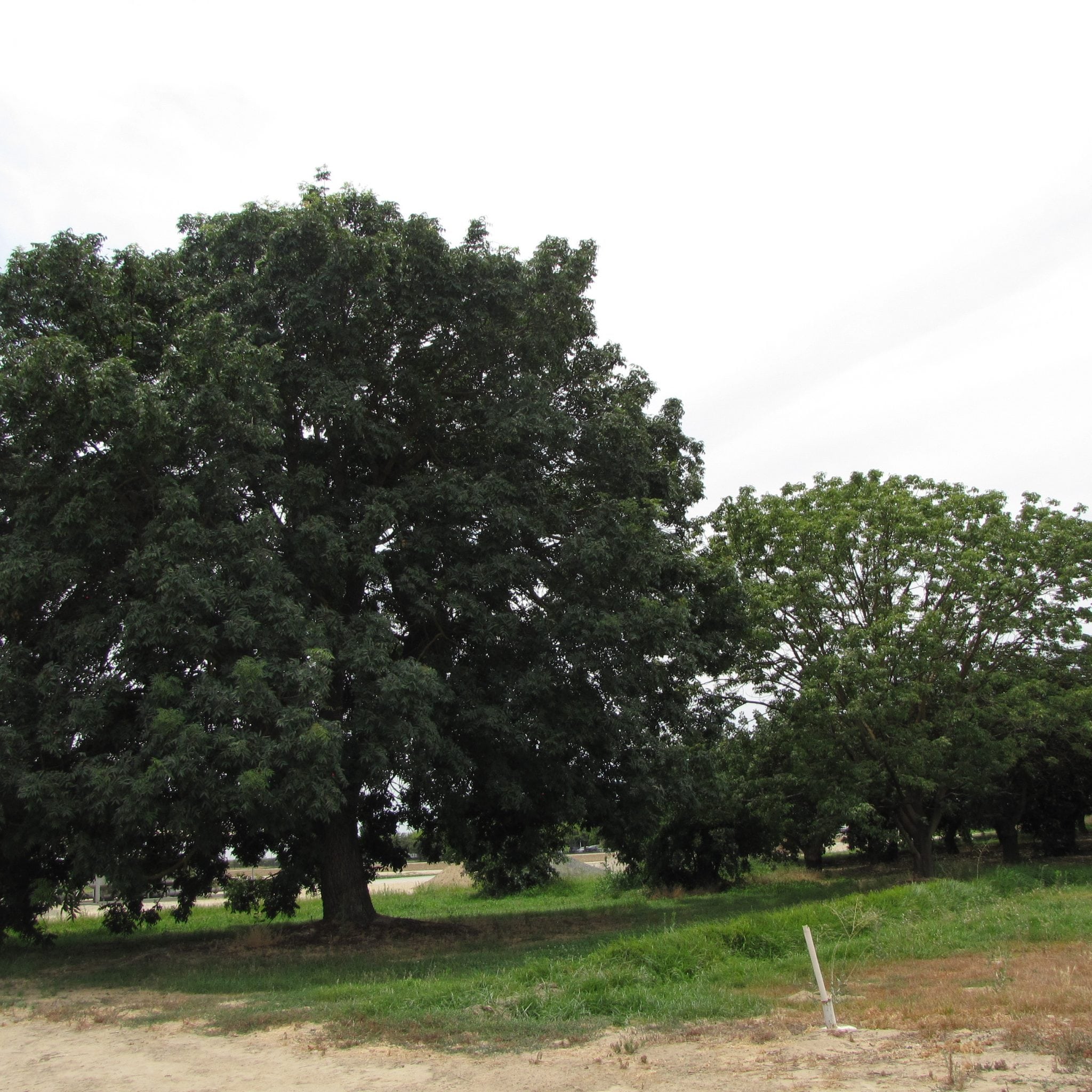
The male pistachio tree dwarfs a newer female. The male tree’s rootstock is the basis for 50% of the rootstock in California. The tree is located at KARE Center near Fresno, Calif.. (Image: RCR Wireless News)
One of the few trees not on rootstock yet are pomegranates. “They are evaluating rootstock in here,” said Dahlberg pointing to a test orchard of pomegranates.
KARE also has some tea plants that researchers salvaged from an abandoned 1960-1970s-era research project funded by Lipton Tea. Lipton funded research at several places around the country because the company was worried it would lose access to its overseas supply of black tea leaves. The company halted the research after China opened up in the ‘70s, but researchers saved about 14 of the best plants and planted them around a building at KARE. “Turns out you can grow really good tea here in the Valley,” said Dahlberg. “This has been growing here since the ‘70s with very little maintenance and fertilizer…. About four years ago, I get a call from a researcher asking why we weren’t working on tea.”
Maybe these are facts only an ag geek can love.
KARE has an educational demonstration orchard of ‘what-not-to-do’ for peach growers. Growers can learn what planting, pruning and irrigation techniques don’t work well by looking at the trees themselves that have been preserved in their less than optimal situations. It’s not the kind of grove any farmer would keep (or admit to keeping), but KARE keeps this educational demo going.
Is there a robot future in store for ag tech? Yes, there is farm labor shortage, said Dahlberg. The shortage was happening before the present U.S. president came into office. A key thing to remember is the farm worker is actually a highly skilled laborer that won’t be easily replaced by robots, by the nature of what they do on their jobs and the decisions they make. The human being is still superior and more versatile for working on multiple crops than are robots, which would have to be trained through an AI database specific to one crop before the robot could make an independent decision about the ripeness of a fruit.
Perhaps someday the fruit will be grown for ease of robot or drone pickers. Regardless, with better connectivity, the future is bright for speeding up some of data collection and interpretation of research at KARE, Lindcove and other UC ANR research centers around the state. Plants may not grow faster (but if there is a way, KARE will try to find it.) Someday perhaps 5G-capabilities may be added to poles in the fields, with the “good bones” in place now serving as a foundation. At that time, KARE may again be the proving ground.
The post High-speed Wi-Fi at ag research center may be blueprint for rural communities appeared first on RCR Wireless News.
